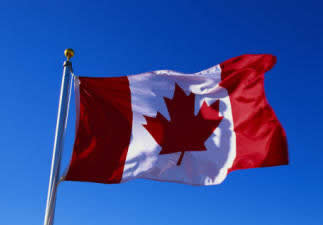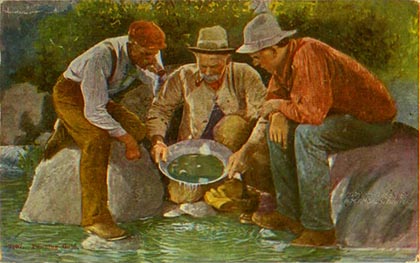Oregon had inside track on California's gold rush
Portlanders found out about gold a month before New Yorkers and had a much shorter voyage to get to the gold fields; the state nearly emptied out as everyone who could go went. They got there first, and many of them were lucky.
EDITOR'S NOTE: A revised, updated and expanded version of this story was published in 2023 and is recommended in preference to this older one. To read it, click here.
By Finn J.D. John — November 5, 2009
“Welcome to Oregon: Population 8,779.” Has a certain ring to it, doesn’t it?
Not even Tom McCall would have welcomed a number that low. But that was the population of the territory of Oregon – including what’s now Washington State – according to the census in 1849.
A year earlier, there’d been three times as many people there. But, of course, you know what happened in 1849. Gold was discovered in California and, although there was quite a bit of gold in Oregon too, it hadn’t been discovered yet.
So southward flew virtually every Oregon citizen capable of putting dirt in a pan and pouring water over it. Crops rotted in the fields.
For a whole lot of them, though, it was worth it. You see, Oregonians had learned of the gold discovery well before anyone back east. And that was primarily because of a sea captain who made a killing in Portland.
This captain had sailed his ship, the Honolulu, into port the previous July, just a few months after gold was discovered. Portlanders thought it odd that he brought the ship in empty, with nothing to sell to them; a couple months later, ships in ballast coming to Portland to take loads of wheat and other foodstuffs across the sea would be very common, but in mid-1848, they were not.
They found it odder that the captain zipped out and started snapping up every pick and shovel he could find. Then, when it was time to pay for his excavation equipment, they found out what he was up to: He paid for it with gold dust. And he told them where he’d gotten it.
So by the time the New York Herald got the word and announced it for the first time on the Eastern Seaboard on Aug. 19, Oregonians had already been pouring over the border to the gold fields for a month. By the time the first ships crammed with gold-rushers got to San Francisco Bay eight months later (remember, there was no Panama Canal yet; they had to sail around Patagonia) the Oregonians had already spent most of a very productive summer and autumn scrounging up the “easy pickin’s” and staking out their pick of available claims.
When they returned to their neglected farms, these Oregonians brought back millions in gold. But they found the folks who’d stayed behind had done almost as well. One couldn’t eat gold; someone had to grow food, and so many of the people who usually do that were digging for gold that there wasn’t much of it, so prices were astronomical. Ship after ship loaded with Willamette Valley food headed down to San Francisco, and brought back even more gold.
Before 1848, Oregon’s economy, such as it was, was barter-based. The provisional/territorial legislature even voted to make wheat legal tender at one point, and territorial governor George Abernethy gave out special rocks as change at his store – they were known, possibly not fondly, as “Abernethy Rocks.” But once all this gold came pouring in, suddenly business owners needed scales to weigh gold dust, a group of citizens started stamping it into $5 and $10 “Beaver money,” and business got quite a lot easier to do.
As the California gold fields filled up with Easterners and treasure-seekers from around the world, most of the Oregonians came home. Some got skunked, but many returned with pockets bulging, and all of them found that they could almost name their price for anything they could grow. Now that mining the mines was no longer particularly profitable, Oregonians found they could do even better by “mining the miners.”
One other thing happened in 1848 as well: Oregon lost its preeminence on the West Coast. In early 1848 there were only 1,000 or so non-Native Americans in California, and many times that in the Oregon Territory. The following year, the ratios would be reversed. Oregon would never again have a bigger population than its sunnier southerly neighbor.
(Sources: Pintarich, D. “The Oregon Gold Rush,” Great Moments in Oregon History, 42. Portland: New Oregon, 1988; Sullivan, W. Hiking Oregon’s History. Eugene: Navillus, 2006)
-30-













